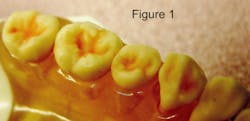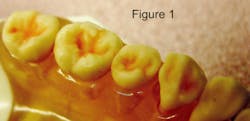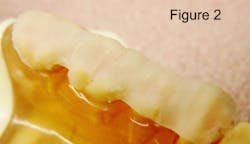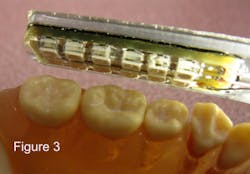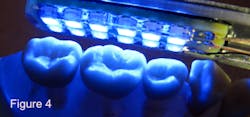Quadrant sealants: Examples of practical placement of dental sealants
By Gregory S. Jacob, DDS
The dental hygienist is a highly talented prevention professional contributing to improve overall public health throughout the nation. One of the many contributions of the dental hygienist involves placing pit-and-fissure sealants to reduce or eliminate the potential of caries on posterior teeth. Once placed over the exposed fissures and pits of tooth enamel, sealants resist the potential ingress of harmful cavity-initiating factors such as bacteria. Many mobile prevention clinics throughout the United States visit schools where the dental hygienist provides young student populations with sealant services.
Currently, sealant placement involves positioning and curing sealants on one tooth at a time and almost exclusively on newly erupted permanent molars. All unsealed primary deciduous teeth of young children are especially susceptible to the aggressive damaging effects of tooth decay, but are usually never sealed. As a result, it becomes important to reevaluate sealant placement and include all posterior teeth of mixed and/or permanent dentitions.
In the past, it has not been feasible to seal all posterior teeth due to technical factors limiting successful sealant placement and retention. Some of these factors include moisture control, patient compliance, sealant material selection, time, and budget constraints.
Despite these and other limitations, sealant materials and techniques have truly advanced to permit sealant placement on multiple teeth over an entire section simultaneously (as in a quadrant) and for greater numbers of patients in about same time frames of professional care dedicated to sealing individual teeth.
This article presents possible techniques to place quadrant sealants in all dentitions using both self-cure and light-cure sealant materials.
Method for quadrant placement of self-cure sealants
Some self-cure sealant materials have advanced to include fluoride uptake and release to further guard against the potential of caries. One such material is shown here (GC Fuji Triage Pink, GC America).
- Check and clean pits and fissures of teeth in quadrant as appropriate. Dry with cotton gauze.
- Place sealant(s) over exposed pits and fissures. One alternative technique (shown) is to use a wiping action across occlusal surfaces, compressing sealant material onto occlusal or facial surfaces (see Figure 1).
- Using flattened rope wax sized to fit quadrant, place over occlusal surfaces, and mold onto buccal and lingual surfaces as needed to prevent moisture ingress (see Figure 2). Remove wax completely after set of self-cure material.
- Check the occlusion for interferences and adjust as needed with hand scalers.
Method for quadrant placement of light cure sealants
When applying low-cost LED technologies that are currently available, light curing of clear sealant materials on multiple teeth simultaneously is now possible. In this case, the material shown is Primedent (Prime Dental).
- Check and clean pits and fissures of teeth in quadrant as appropriate. Dry with cotton gauze.
- Place sealant(s) over exposed pits and fissures according to sealant manufacturer’s directions.
- Place quadrant sealant curing light over quadrant and activate for sealant curing as needed (see Figures 3, 4). Note: Cross contamination barriers for curing light units omitted from photos for clarity).
- Check the occlusion for interferences and adjust as needed with hand scalers.
As the need for effective prevention increases, the dental hygienist must accommodate to expand overall prevention goals in the area of dental pit and fissure sealants. There is no disadvantage to further investigation and/or development of quadrant sealant placement methods, materials, and equipment.
If widely adopted as a new standard of preventive care, quadrant sealant placement offers a new basis for the possible future goal to eliminate an entire category of dental caries. Once tested and proven feasible, there would be significant support for the dental hygienist in routinely placing multiple sealants from both the public and healthcare authorities. It is possible now to help establish quadrant sealant placement as a new and more comprehensive routine preventive measure led by the dental hygienist.
Dr. Gregory Jacob is in private practice in Glenview, Ill.
